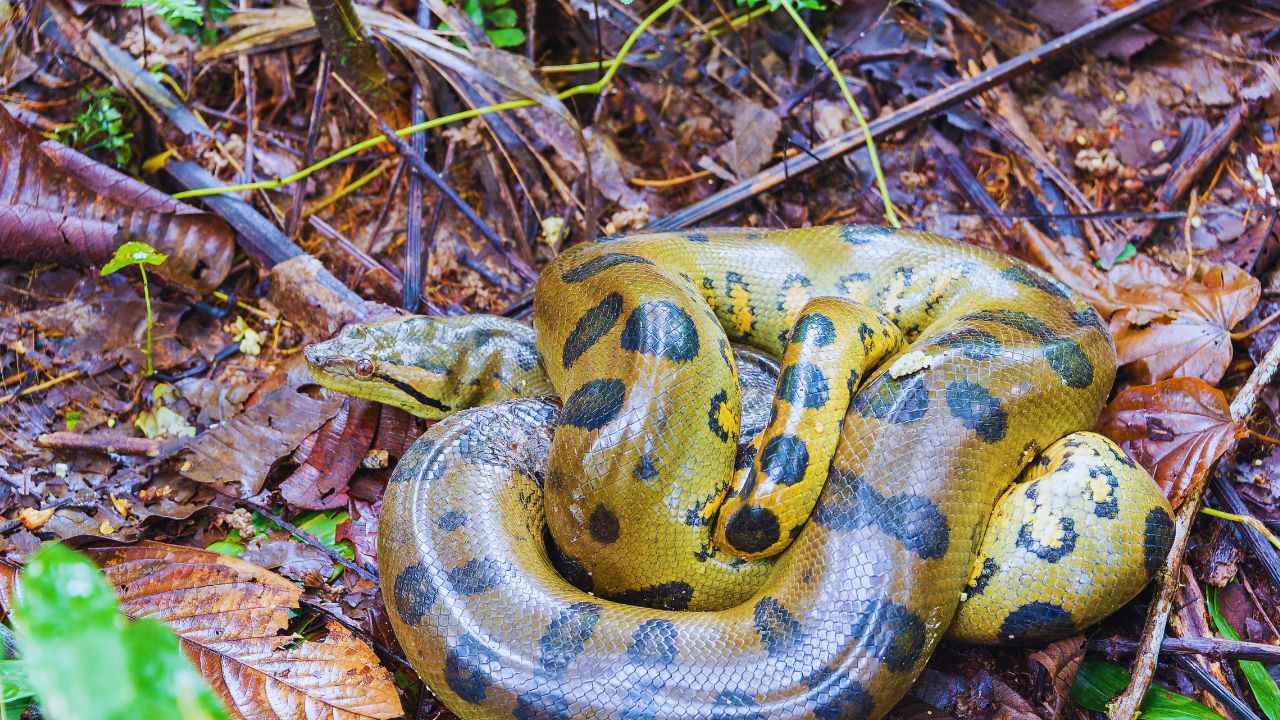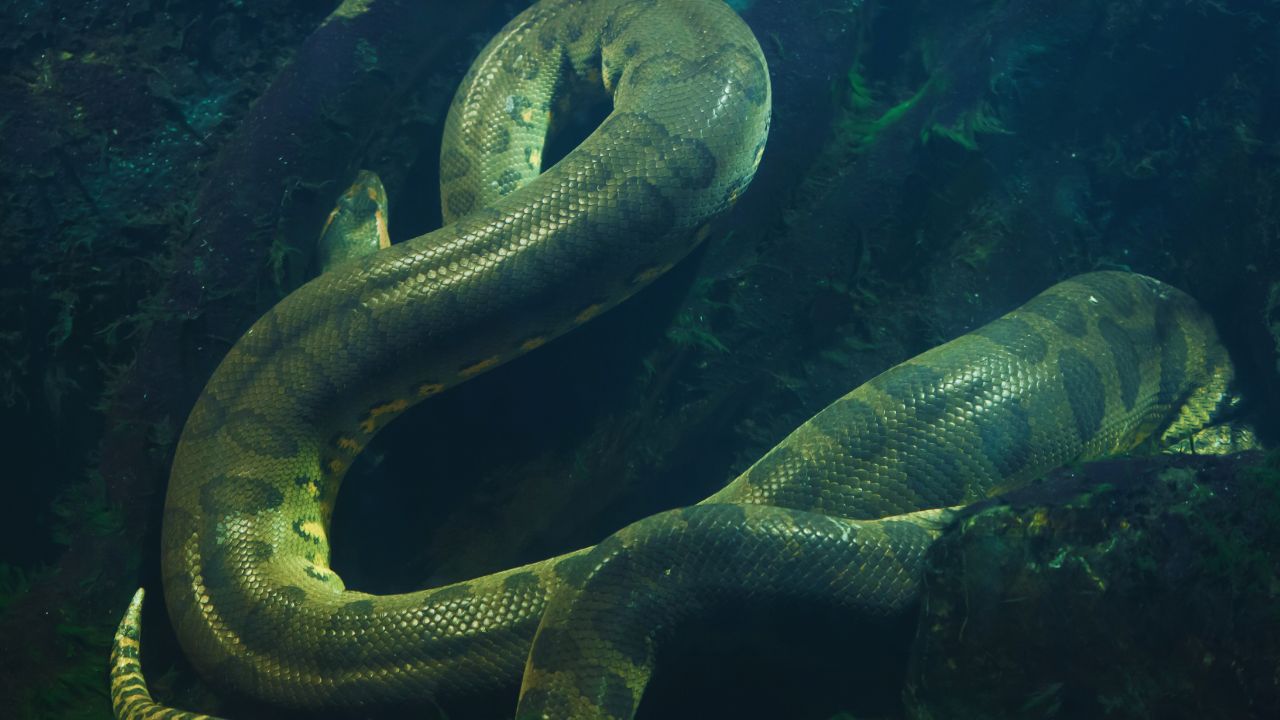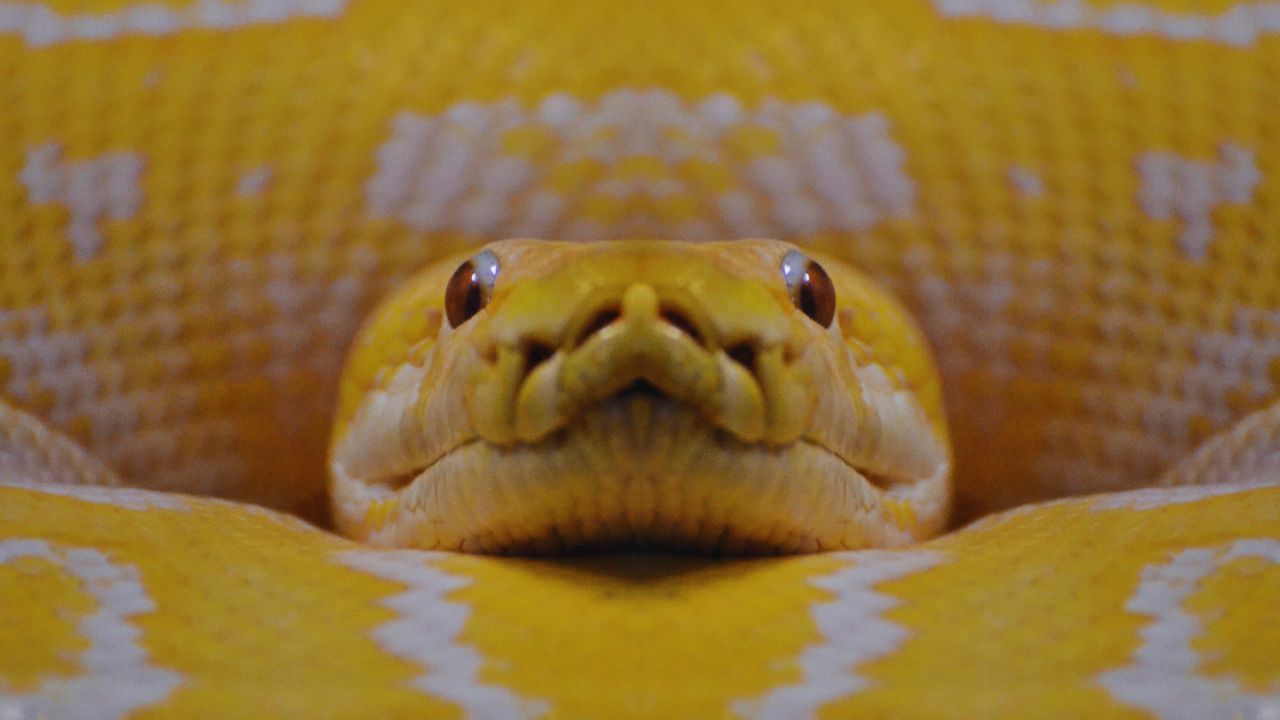The fascinating Yellow Anaconda (Eunectes notaeus), which is indigenous to South America’s river systems, is often eclipsed by its more well-known cousin, the Green Anaconda. Despite this, the Yellow Anaconda is a unique animal all by itself, exhibiting a variety of intriguing traits and behaviors that have allowed it to flourish in the varied and sometimes harsh conditions of its native habitat.

Overview of Yellow Anaconda Characteristics
| Category | Details |
|---|---|
| Scientific Name | Eunectes notaeus |
| Habitat | Wetlands, marshes, and slow-moving rivers in Paraguay, southern Brazil, Bolivia, and northeastern Argentina |
| Distribution | Primarily in South America, habitat dictated by the availability of water |
| Physical Features | Yellow body with dark brown/black blotches, 10-15 feet in length, muscular build, small head, vestigial hind limbs (spurs) |
| Behavior | Nocturnal, opportunistic predator; hunts in water and on land using constriction |
| Diet | Fish, birds, mammals, and reptiles; diet vary based on availability |
| Reproduction | Ovoviviparous, with a gestation period of 6 months, females give birth to 15–30 live young |
| Lifespan | 15-20 years in the wild; up to 25 years in captivity |
| Conservation Status | Listed as “Least Concern” by the IUCN |
| Human Interaction | Revered in indigenous cultures; part of ecotourism, it faces threats from habitat destruction and human conflict |
Distribution and Habitat
The main habitats of the Yellow Anaconda are marshes, wetlands, and slowly flowing rivers in northeastern Argentina, Bolivia, Paraguay, and southern Brazil. These areas give this semi-aquatic snake the perfect habitat because of their many water sources and thick foliage, which provide cover from possible predators as well as plenty of hunting chances. The fact that the snake favors these settings shows how adaptable it is and how important an apex predator it is in these ecosystems.
The presence of water greatly influences the Yellow Anaconda’s range. These snakes can distribute more widely because they have access to a greater variety of habitats during the rainy season, when rivers rise and floodplains increase. They are often restricted to the remaining bodies of water during the dry season, which might intensify competition for those resources. This seasonal variation in habitat availability emphasizes how crucial water is to the Yellow Anaconda’s life cycle.
Physical attributes
Though not as enormous as the Green Anaconda, Yellow Anacondas are nonetheless large snakes. They can grow to a maximum length of 10 to 15 feet; however, some individuals may grow longer than this. Their powerful, thick bodies are made for constriction, which is a hunting technique they use to tame their prey.
One of the snake’s most remarkable characteristics is its coloring. The Yellow Anaconda, as its name implies, is mostly yellow with a pattern of dark brown or black blotches and dots that help it blend in perfectly with the dappled light of its watery habitat. This coloring helps the snake hide from any dangers and keeps its victim from seeing it until it’s too late.

The eyes and nose of the Yellow Anaconda are situated on top of its rather tiny head in relation to its size. This adaptation helps the snake have a semi-aquatic existence since it lets it see and breathe while keeping the rest of its body submerged. In addition, Yellow Anacondas share characteristics with other members of the Boidae family, such as the vestige of hind limbs known as spurs, which are more noticeable in males and are used during mating.
Conduct and Hunting Methods
Being largely nocturnal, the Yellow Anaconda hunts by taking advantage of the cover of darkness. It is a predator that seizes opportunities, consuming a diverse range of food items such as fish, birds, mammals, and even other reptiles. The snake is known to modify its hunting techniques in accordance with the availability of food in its surroundings, which greatly influences its diet.
The Yellow Anaconda is a very proficient predator when it comes to the water. It approaches its victim stealthily by using its strong muscles to move through the water with little effort. When the target is within striking range, the snake constricts the victim by encircling its body around it and using its pointed, backward-facing fangs to grab hold of it. As the prey’s blood supply is abruptly cut off by the snake’s muscular coils, unconsciousness and death ensue. This method of killing is both effective and lethal.

The Yellow Anaconda is less nimble but still rather strong when it is on land. It often waits around water sources so it may surprise visiting animals with a sip. The snake can wait for the ideal chance for hours or even days, thanks to its patient disposition and coloring, which makes it a proficient ambush predator.
Yellow Anaconda: Habitat, Behavior, and Ecological Role
| Aspect | Description |
|---|---|
| Habitat and Distribution | Wetlands, marshes, and slow rivers; found in Paraguay, southern Brazil, Bolivia, and northeastern Argentina; distribution tied to water availability |
| Behavior and Hunting | Nocturnal, efficient swimmer; hunts by constriction, both in water and on land; utilizes ambush techniques, especially near water sources |
| Physical Adaptations | Yellow with dark blotches; muscular body; small head with eyes and nostrils on top; vestigial hind limbs (spurs) |
| Reproduction | Ovoviviparous; males track females by pheromones; gestation of 6 months; 15–30 live young per brood |
| Ecological Role | Apex predators help regulate prey populations, contributing to ecosystem balance |
| Threats and Conservation | Faces habitat destruction, hunting by humans, and skin trade; classified as “Least Concern” by IUCN |
Lifespan and Reproduction
Equally remarkable are the Yellow Anaconda’s breeding practices. These snakes are ovoviviparous, which means that instead of laying eggs, the females give birth to live offspring. Since there is less water during the dry season and snakes are more likely to meet, mating usually takes place at this time. Pheromones are used by males to track females, and it is not unusual for many males to fight for a single female.
Following a successful mating attempt, the female spends around six months in gestation. She will often become less active during this time and concentrate on locating remote, secure locations where she may give birth. When the time comes, she will give birth to a brood of fifteen to thirty live offspring, each of which will be around two feet long.
From birth, the children are on their own and do not receive parental care. Though they are susceptible to predators until they reach a greater size, they are completely capable of hunting and surviving on their own. Although the longevity of a Yellow Anaconda in the wild is unclear, it is thought to be between 15 and 20 years. These snakes have considerably longer lifespans in captivity—some have been known to live up to 25 years.
Ecological Function and State of Conservation
The Yellow Anaconda is an important member of the ecosystems it lives in. Being a top predator, it keeps other species’ numbers in check and prevents any one group from being too dominant. The stability and well-being of these ecosystems depend on this equilibrium.
But much like many other huge predators, human activity poses a danger to the Yellow Anaconda. The degradation of habitat, especially wetlands drained for agricultural purposes, is a major threat to the survival of the snake. Furthermore, even though these snakes seldom endanger humans, individuals who are afraid of them sometimes kill them. Additionally, there is a little but ongoing trade in Yellow Anacondas because of the great value placed on its skin due to its unique patterns.

The International Union for Conservation of Nature (IUCN) presently lists the Yellow Anaconda as a species of “Least Concern” despite these difficulties. According to this categorization, there is currently no imminent threat to the extinction of the species. However, to guarantee that the Yellow Anaconda continues to be a healthy member of South America’s natural heritage, monitoring and conservation activities must be ongoing.
Human Relationships and Cultural Importance
The people that live in the Yellow Anaconda’s range have been enthralled by it throughout history. These snakes are respected as strong spirits or as representations of water and fertility in many indigenous cultures. Their representation in these cultures’ mythology and folklore illustrates the close connection that exists between the populace and their surroundings.
Even in contemporary times, the Yellow Anaconda remains a fascinating animal for both residents and tourists. For certain communities, ecotourism that revolves on seeing animals, including snakes, has grown to be a significant source of revenue. A deeper understanding of these snakes and their essential function in the ecosystem may result from the increased interest in nature.
Yellow Anaconda’s Physical and Behavioral Traits
| Category | Details |
|---|---|
| Physical Traits | Large snake (10–15 feet); yellow with dark blotches; muscular; small head; nostrils and eyes on top |
| Coloration | Predominantly yellow with dark brown/black blotches; excellent camouflage in aquatic environments |
| Behavioral Traits | Nocturnal, ambush predator; uses constriction to kill prey; opportunistic, adaptable in diet and hunting methods |
| Reproductive Traits | Ovoviviparous; gestation lasts 6 months; gives birth to 15–30 live young |
| Lifespan | 15-20 years in the wild; up to 25 years in captivity |
| Ecological Importance | Apex predator in wetlands and rivers help maintain population balance among prey species |
| Human Interaction | Often feared but significant in local cultures; role in ecotourism; threatened by habitat loss and human conflict |
It is not generally given the credit it deserves, but the yellow anaconda is an amazing creature. It is an amazing creature of the natural world, extraordinary in its size, colors, and adaptability. It’s becoming more and more obvious that the Yellow Anaconda is not simply a dangerous predator but also an essential part of the ecosystems it lives in as we learn more about this mysterious snake. We can contribute to ensuring that this species survives for many more generations by learning about it and taking protective measures.





